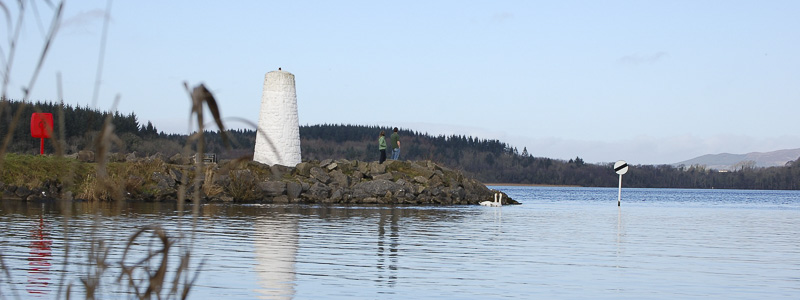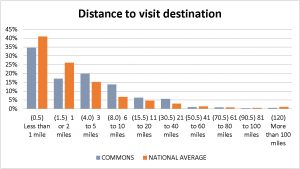By Pippa Langford, Principal Specialist Commons and Rights of Way, Natural England
(in Volume 29)
Almost all commons have public access, either because they had public access before the Countryside and Rights of Way Act 2000 or because all Registered Common Land was a category of land that was mapped as access land by CROW. Many commons are also crossed by public rights of way.
Recreation on commons needs to be considered when changes to the management of a common have the potential to impact upon people’s use. These changes could be intended to increase overall recreational activity, for example by holding events, or they could be changes that aim to improve the safety of livestock or increase biodiversity which might make it more difficult for some people to access the common. Understanding what people do on commons before considering management changes is therefore a key part of “A Common Purpose” (Natural England 2012) the engagement process endorsed by Defra’s National Common Land Stakeholder Group. Understanding what the Monitor of Engagement with the Natural Environment (MENE) tells us about what people do on common land is a useful component of this process.
The MENE survey is funded by Natural England, with support from Defra and the Forestry Commission. Since 2009 the MENE survey has provided trend data for how people use the natural environment in England. Every year at least 45,000 in-home interviews are undertaken. The survey collects information about the ways that people engage with the natural environment such as visiting the countryside, enjoying green spaces in towns and cities, watching wildlife and volunteering to help protect the natural environment.
The data collected about how people use the natural environment includes the type of destination, duration, mode of transport, distance travelled, expenditure, main activities, motivations and barriers to visiting. From analysing many years of MENE data we know that patterns of access and recreation to the natural environment are fairly stable. MENE reports are available from GOV.UK
In September 2014, the UK Statistics Authority completed their assessment of MENE and designated the output as National Statistics. Data from the MENE survey on green space use is also included in the Public Health Outcomes Framework indicator. This provides information on the percentage of people using outdoor places for health or exercise reasons. This data helps inform local government public health expenditure.
Understanding how people use common land for recreation is therefore also important for identifying and assessing the public benefits, such as health and wellbeing, that arise from the public’s use of commons for recreation.
From a policy perspective the value of recreation should not be overlooked when calculating the natural capital value of common land. “Natural capital is the stock of natural assets which include geology, soil, air, water and all living things. It is from this natural capital that humans derive a wide range of services, often called ecosystem services, which make human life possible.” (World Forum on Natural Capital). Recreation is a type of ecosystem service.
It is important to note that public benefits and natural capital are not the same thing and are measured in different ways. To assess the natural capital value of outdoor recreation the Office for National Statistics uses a value per visit which is an exchange value (what people would pay). A different method would be required to estimate the value to society, what economists call the ‘welfare value’.
Recreation on Commons – what does MENE tell us?
In 2015 Natural England analysed MENE data from 2009-2014 to assess the data on commons compared to the national average with respect to what activities people engage in, visit motivations and distance travelled.
Table 1 MENE data of activities engaged in the natural environment, national average and on common land[1]
| Activity | National Average (% of total) |
Common (% of total) |
| Walking without a dog (including short walks, rambling or hill walking) | 27 | 39 |
| Walking with a dog (including short walks, rambling or hill) | 49 | 36 |
| Playing with children | 8 | 12 |
| Off road cycling or mountain biking | 1 | 4 |
| Running | 3 | 5 |
| Off road driving or motorcycling | 0 | 1 |
| Picnicking | 1 | 2 |
| Road Cycling | 2 | 3 |
| Appreciating scenery from a car | 1 | 3 |
| Swimming outdoors | 0 | 1 |
| Beach, sunbathing or paddling | 2 | 1 |
| Visiting an attraction | 3 | 4 |
| Informal games and sport (for example frisbee) | 2 | 1 |
Of most interest is the data on walking with or without a dog. It had been thought by some commentators that there was considerably more dog walking on commons than elsewhere, but the data shows this not to be the case (36% on commons compared to 49% national average). This finding is at odds with other studies on access to commons which are also heaths in the south east of England, which show dog walking to be a major activity. Conversely walking without a dog is a more frequent activity on commons than the national average (39% compared to 27%). However if we consider the nature of common land and the location and physical features of common land then it is clear that the data will reflect that a significant proportion of common land is the uplands in the northern and western parts of England, and these are large commons, not close to where significant numbers of people live who would engage in their daily dog walk. This contrasts with commons in lowland areas which are more numerous but much smaller in area and close enough to many people to be the location for dog walking.
Other notable differences are the rates for running, off road cycling and playing with children. The attractions of commons for runners could be explained by the ability to go anywhere and therefore vary routes more easily compared to running on linear routes.
Further analysis of the locations for “off road cycling” would be useful. Many commons do not have access rights for cyclists other than on public bridleways so the data suggests that cyclists are using routes which are not designated for cycle use. This would be in line with the findings in Cycling UK’s report “Rides of Way” (Allen C. 2017) in which 4/5ths of respondents stated that they ride on footpaths or undesignated trails. Many people who ride off road on undesignated trails do so to avoid traffic so if we are to attract more people to the natural environment we may want to consider how cyclists might access commons in the future.
To understand the reasons for the relatively high numbers of people “playing with children” on commons it would be useful to do more detailed analysis of the locational data. Some commons have designated children’s play areas so it may be these that are attracting families but we have not yet carried out detailed analysis to know if this is the case.
Table 2 Visit Motivation – motivators that are more significant on commons
| Motivation | National Average (% of total) |
Common (% of total) |
| For fresh air or to enjoy pleasant weather | 28 | 47 |
| For peace and quiet | 16 | 28 |
| To relax and unwind | 30 | 44 |
| To enjoy scenery | 20 | 42 |
| For health or exercise | 44 | 49 |
| To enjoy wildlife | 13 | 16 |
| To be somewhere you like | 16 | 19 |
It appears that the intrinsic qualities of commons are valued by people rather than them being places for social activities. Other reasons within the MENE survey for visiting the natural environment include: to spend time with family, to spend time with friends, to exercise your dog, to entertain children, to challenge yourself, on all of these motivators commons scored lower than the national average.
However the results that people use commons as places to find peace, to relax, to enjoy scenery and wildlife, for health and exercise all show that commons are valuable places for people’s physical and mental wellbeing. These findings are all in line with studies which assess the recreational benefits of “greenspace”. For example one of the latest studies (Bakolis et al 2018) found that being outdoors, seeing trees, hearing birdsong, seeing the sky, and feeling in contact with nature were associated with higher levels of mental wellbeing. Also better greenspace access is associated with higher reported recreational walking (Lachowycz K and Jones AP 2014) and older people living in greener neighbourhoods experienced less of a decline in physical activity than those living in less green areas (Dalton et al 2016).
Considering people’s high levels of motivation to visit commons it should not be a surprise that MENE also tells us that people travel further to commons than for their average visit to the natural environment (see Chart 1). This tendency for people to travel further to visit commons is an important one to note since it should inform future natural capital valuations.
Chart 1 Distance travelled to place visited (miles): commons and the national average
To conclude, MENE tells us that commons are valued by people as places for recreation, people are motivated by the quality of their experience to visit commons and people travel further to visit them compared to other areas of the natural environment. Further work to calculate the natural capital valuation of commons and the public benefit from recreation would be of use. At a time where there is a drive to target public funding to deliver public benefits it would also be relevant to consider how commons might better meet the needs of recreational users in the future, particularly those who may be currently excluded including the disabled, cyclists and horse riders.
References
Allen C, 2017 Rides of Way: Cycling UK’s Off-Road Report 2017, pub Cycling UK, Guildford.
Bakolis I, Hammoud R, Smythe M, Gibbons J, Davidson N, Tognin S, Mechelli A, 2018 Urban Mind: Using Smartphone Technologies to Investigate the impact of Nature on Mental Wellbeing in Real Time, Bioscience Volume 68, Issue 2, 1 February 2018, Pages 134–145, https://doi.org/10.1093/biosci/bix149
Dalton AM, Wareham N, Griffin S and Jones AP 2016, Neighbourhood greenspace is associated with a slower decline in physical activity in older adults: A prospective cohort study, SSM Population Health 2 Pages 683-691
Lachowycz K and Jones AP 2014 Does walking explain associations between access to greenspace and lower mortality? Social Science and medicine, pages 9-17
Natural England (2012) A Common Purpose: A guide to Community Engagement for those contemplating management on Common Land (revised edition 2012), https://historicengland.org.uk/images-books/publications/common-purpose/
[1] Note that numbers do not total to 100% as only the figures which show a significant difference are included and more than one activity can be undertaken per visit.

